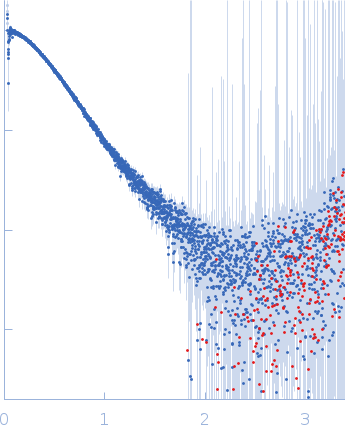|
Synchrotron SAXS
data from solutions of
Fas-activated serine/threonine kinase/phosphoprotein FASTK (76-549)
in
50 mM Tris-HCl, 5% (v/v) Glycerol, 200 mM Ammonium Sulphate, 50 mM NaCl, 0.5 mM TCEP, 10 mM Glutamic acid, 10 mM Arginine;, pH 8.5
were collected
on the
B21 beam line
at the Diamond Light Source storage ring
(Didcot, UK)
using a Eiger 4M detector
at a sample-detector distance of 3.7 m and
at a wavelength of λ = 0.094 nm
(I(s) vs s, where s = 4πsinθ/λ, and 2θ is the scattering angle).
In-line size-exclusion chromatography (SEC) SAS was employed. The SEC parameters were as follows: A 45.00 μl sample
at 8.9 mg/ml was injected at a 0.08 ml/min flow rate
onto a GE Superdex 200 Increase 3.2/300 column
at 15°C.
620 successive
3 second frames were collected.
The data were normalized to the intensity of the transmitted beam and radially averaged; the scattering of the solvent-blank was subtracted.
To obtain P(r) data were processed with BIFT based on q range (1/A) 0.0046 to 0.1604
|
|
 s, nm-1
s, nm-1